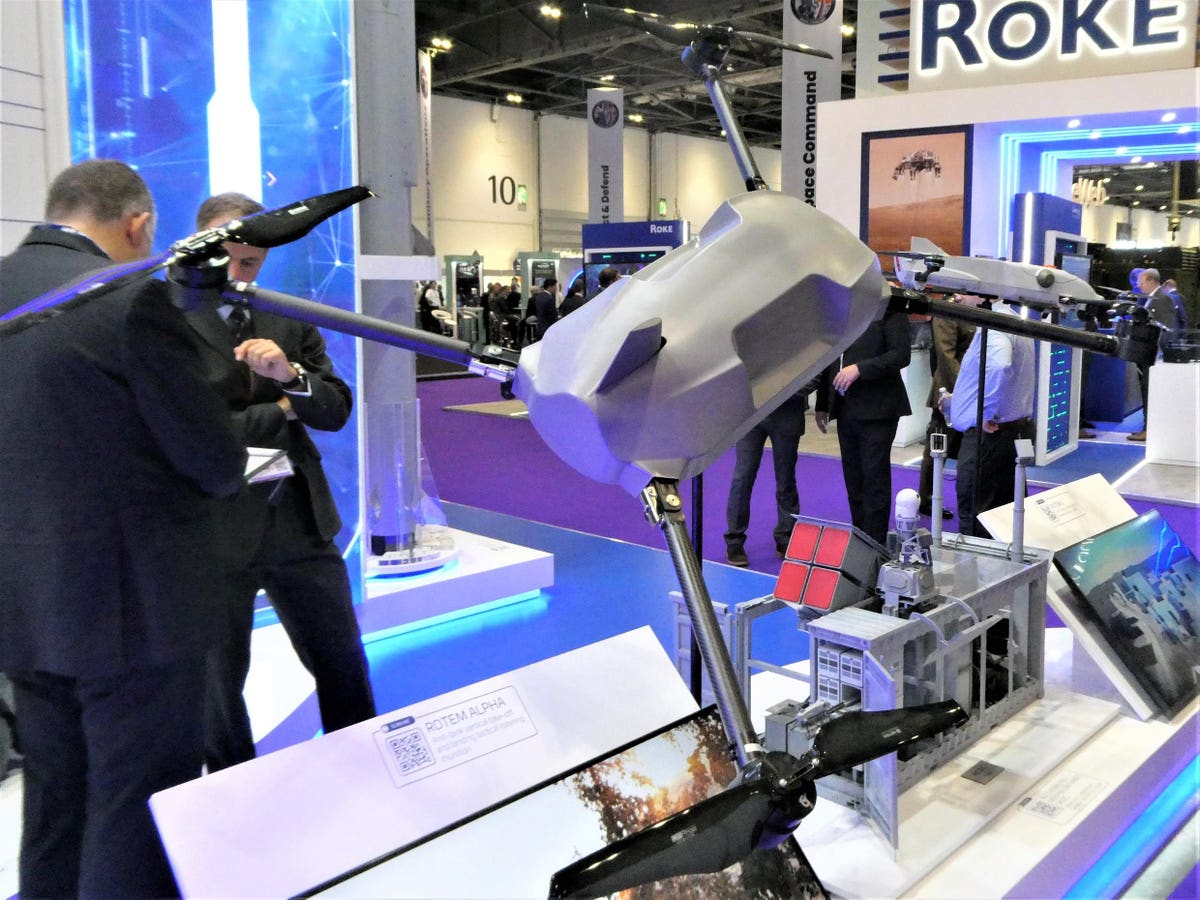The Ukrainian conflict has seen the rapid rise of kamikaze FPV drones, racing quadcopters fitted with explosive warheads, now produced by the thousand by both sides. These are cheap enough to be used against individual footsoldiers, but powerful enough to take out the latest T-90M Russian tanks. FPV kamikazes were first seen a year ago in Ukraine – but quadcopter loitering munitions go back further than that, and the Israeli inventors have just unveiled a far more powerful version at the DSEI show in London.
Back in 2016 Israeli defense firm IAI released the Rotem-L. Unlike earlier loitering munitions, such as the same company’s Harop, this has a rotorcraft configuration, and resembles a commercial FPV drone with a nose-mounted camera. The selling point for Rotem—L is its maneuverability and ability to operate in tight spaces such as urban terrain, with sonar sensors and automated obstacle avoidance.
The Rotem-L makes free use of off-the-shelf drone components and has a flight time of half an hour. It weighs around twelve pounds and carries a two-pound warhead. Tailored to the requirements of the IDF, it is a precision anti-personnel munition which can be used where more powerful weapons carry an unacceptable risk of collateral damage. Unlike the improvised FPVs seen in Ukraine, the Rotem-L has thermal imaging for night operations and tracking that allows the operator to lock on to a target.
Finally, it is reusable: if no target is located, the ROTEM-L can be safely recovered. This is not an issue for FPVs costing a few hundred dollars, but is a useful feature for more costly military hardware.
Seven years on, drone technology has advanced, and at the DSEI show in London this week IAI unveiled a more advanced version: Rotem Alpha with the tag “Bringing next level Anti-Tank dominance to the battlefield.”
IAI say Rotem Alpha can be carried in a backpack and readied in two minutes, though this relies on the operator being able to haul a backpack with 55 pounds of drone in addition to their other gear. It carries a shaped charge warhead claimed to penetrate up to 600 mm (two feet) of armor plate, enough to destroy the heaviest of tanks.
Flight endurance is given as one hour and the range is “tens of kilometers.”
So far Rotem Alpha just looks like a super-sized Rotem-L for the anti-vehicle rather than anti-personnel role. But what makes it more interesting is the new technology included.
Rotem Alpha has a ‘perch and stare’ capability: the operator can land the drone on a building or hill and wait until the enemy approaches before ambushing them. This is similar to the hibernation mode being developed for Russian FPVs, except the drone can position itself rather than having to be manually positioned.
The new version also has more advanced sensors; in addition to daylight and night cameras, it has an acoustic sensor suite, which is likely able to pick up enemy vehicles by their engine noise, or to detect and locate gunfire. The Rotem-L is notably quiet in flight, and the presence of these sensors suggests that the bigger version is quiet enough not to interfere with sound sensors.
“ROTEM Alpha autonomously detects and locates enemy hostile fire sources like artillery, rockets, and missiles launchers, then investigates and engages a direct attack using its electro-optical day and night seeker,” according to the drone’s product page.
Presumably the human operator is in the loop during this attack sequence, but it suggests that Rotem Alpha can be positioned close to the front line, or patrol beyond it, to hunt and destroy enemy artillery. This echoes the IDF’s use of swarming drones to rapidly locate and engage militants launching rockets into Israel in 2021, after they proved too fast to tackle by conventional means. Small FPVs have proved surprisingly effective at taking out Russian artillery, and the bigger version will be able to strike much further behind the lines.
Rotem Alpha also looks like a highly effective anti-tank weapon, with the ability to seek out and identify targets before attacking them. It is in the same class as many of the heavy drone bombers deployed by Ukraine, but with a single powerful warhead to guarantee a first-round kill rather than the multiple weapons seen in Ukraine, and with much greater range. Smaller weapons frequently require several hits to take out even lightly-armored targets.
Previously large, long-range, long-endurance loitering munitions have been of the fixed-wing type, like the Russian Lancet. This has enjoyed some success in Ukraine, including apparently destroying German Leopard 2 and British Challenger 2 tanks. A hovering munition has greater opportunity to carry out close-range observation and inspection of the target area, and it has definite advantages in urban terrain and other difficult environments.
Whether the Rotem Alpha really will bring “anti-tank dominance” is another question. But the success of large multicopters in Ukraine, combined with IAI’s know-how and experience in building this type of drone, suggest that it will create real headaches for tank commanders. But its real value may be in the counter-battery mission where it could find and silence enemy artillery more effectively than anything yet seen.
Read the full article here





